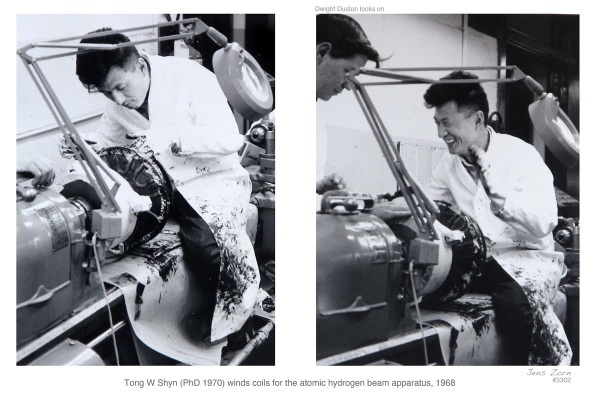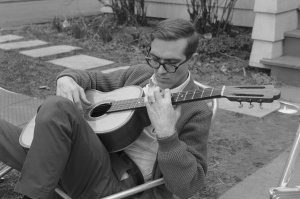LEVEL CROSSING in RETROSPECT
Robert R. Lewis, Professor of Physics Emeritus, University of Michigan
Comments and recollections (2005) on the genesis of the paper “Novel Method of Spectroscopy”
by F D Colegrove, P A Franken, R R Lewis and R H Sands, Phys. Rev. Letters 3, 420 (1959)
Introduction
I have had genuine reluctance to talk about things which happened here 35 years ago, because of a belief in Satchmo Page’s approach to growing old “NEVER LOOK BACK – YOU DON’T WANT TO KNOW WHAT’S BEHIND YOU!”. In fact, it has been fun to meet old friends and to remember the way things were. I’d like to thank Jens Zorn for prodding me into looking back at the work on level crossing spectroscopy. The recollections are necessarily very personal. But all four of the authors are here; in a few moments, the others will get their chance to correct my faulty memory.
Before the Level Crossing
The work was done in the summer and fall of 1959, just one year after my return to UM, and I was just getting settled into a new job and new house. We were expecting our fourth child, so our lives were very full. I was not a regular member of the resonance group, but I often joined the Saturday lunches at the Brown Jug, the nickel bets and the arguments about Resnick & Halliday problems. Physics was exciting then, or perhaps we were all more excitable.
To explain my particular point of view, I have to start the story one year before the experiment had begun. I had come to AA via a summer job at Oak Ridge National Laboratory, as guest of M E (Morrie) Rose, a theorist at Oak Ridge and a UM graduate. We had a common interest in the angular correlation of nuclear radiation and had spent the summer in a fruitless search for “accidental degeneracies” between nuclear gamma rays. The entire theory of angular correlation rested on the interference of different paths in a decay scheme: with transitions A => B => C via a group of intermediate states B, usually the 2J + 1 states with “normal degeneracy” [Figure 1]. It was well understood that when the sub-states B were separated by more than their natural width, the angular correlation would change, leading to “perturbed angular correlations”. The theory of all this was thoroughly worked out in the literature, in part by Morrie Rose, and there were many experiments to illustrate it. This was the main “industry” for doing nuclear spectroscopy, determining spins and parities of nuclear level schemes.
In the summer of 1958, I had suggested to Morrie the possibility that in some nucleus there might be two ”different” groups of states B, B’ which nearly coincided, an “accidental degeneracy”. There should then be an anomaly in the angular distribution of the gamma radiation, due to interference of the paths ABC and AB’C [Figure 2]. We invested quite a lot of time looking through the nuclear data tables and talking to experimenters, without finding a good case. It was the proverbial “search for a needle in a haystack”: nuclear levels have gamma widths Γ ~ 10-2 eV and separations ΔE ~ 10+5 eV, so we had a chance of success about 1 in 10 million! We never considered looking at atomic transitions, where the level spacings are much closer. And we never dreamed of moving the levels into degeneracy; we were thinking about nuclear physics where such things were not possible!
Near the Level Crossing
I first learned of the helium experiment about one year later . It had been underway for some time, and was originally planned as a search for the electron spin resonance in triplet helium. This required a strong magnetic field applied to a sample of metastable helium atoms. When the magnetic field was turned on, two strong resonances were seen unexpectedly at low magnetic fields, about 600 Gauss. From the beginning, it was understood that these resonances were at the location of the crossing of 3P levels; the results for the fine structure separation were presented at the optical pumping conference that summer (1959). The question was not “where” these resonances occur but “why”. Peter Franken went from door to door down the first floor of Randall (theory row), trying to interest people in this problem.
I was slow to respond because I didn’t really understand what they were doing. I had never worked in atomic physics and only knew what we had all learned from studying quantum mechanics. I was teaching the graduate courses in quantum mechanics and was immersed in the quantum description of everything. After several visits from Peter (he was very persistent!), I agreed to visit the lab one Saturday and look over the apparatus [Figure 3], a standard Varian magnet with a helium discharge lamp and a helium sample between the pole tips. I watched the scope as they tuned the magnet, giving a nice Lorentzian in the transmitted light, [Figure 4]. But I still didn’t understand what they were doing, and why the resonance was a problem.
What motivated me to continue was to explain it all in quantum language: I was struck by how much they used classical physics instead of quantum physics in their discussions. I’m sure I was a bit arrogant about this; it seems to me now that the essential (missing) point could have been understood either in quantum or classical terms. Nonetheless, I thought I understood the origin of a “Lorentzian resonance” in a quantum system, in terms of the effect of an oscillatory perturbation , a la Schiff. If the frequency ω were tuned to the energy difference (E1 – E2), the transition probability would go through a maximum [Figure 5]. Note that the abscissa in Figure 5 is frequency, whereas Figure 4 was drawn versus magnetic field; that detail had not penetrated my thinking. Actually, Schiff’s approach was appropriate for the ESR signal and most other resonances observed by the “resonance group”, and therein lay the puzzle. It simply didn’t predict anything special when two levels crossed!
Fortunately, after 35 years one forgets all the blundering and confusion, but I remember with startling clarity the time and place at which things suddenly “clicked”· It was a hot Saturday in July; we were getting ready for a cocktail party in our basement to avoid the heat and I was driving east along stadium Blvd, heading for the Party Store to get the drinks. As I approached the light at Main Street, it suddenly hit me: they were not tuning the perturbation a la Schiff, they were changing the magnetic field to produce an “accidental degeneracy”. Then things began to fall into place for me, the light not being emitted or absorbed but was scattering via two paths which were interfering when two levels overlapped. This was the optical analogue of the effect Rose and I had searched for in nuclear gamma rays, except that one photon was being absorbed and the other emitted, instead of two successive emissions [Figure 6). The intermediate energy levels versus magnetic field were being probed [Figure 7].
It was then a simple exercise in quantum mechanics to calculate the amplitudes of the various paths, adding them coherently at resonance and adding them in quadrature when they were far apart. It had all been reduced to algebraic tables of the dipole moments from Condon & Shortley. predict which level crossings would interfere, and how the results would depend on the light polarization.
My next most precious memory is another Saturday, probably just one week later; as I recall it, everything interesting happened on a Saturdays. I think I was busy with classes and other things all week long and was a “resonance physicist” on the weekends. There was a sacred tradition of contesting important ideas with “nickel bets”; the real money was involved, but the stakes were much higher than the coins we used. I remember winning three nickels from Peter IN ONE SATURDAY. Unfortunately, I can only remember what two of the bets were about; the third nickel has fallen through the cracks in my memory.
The first bet was about the dependence on the polarization: the “back of the envelope” algebra indicated a strong dependence on polarization but the polarization didn’t seem to affect the experimental signal. Peter became suspicious of the Polaroid they were using, so he cut two new pieces and rotated one in front of the other in the 1 µ light from the helium lamp; again nothing happened. What had been sold as a polarizing material simply didn’t polarize at 1 µ! Remember that the line was not visible, so one couldn’t SEE any of this. With a better polarizer, the dependence on polarization was observed and a nickel changed hands.
Another bet concerned the behavior in the forward direction: the detector was mounted straight ahead of the sample, but our algebra said the total cross section should not show a signal. We eventually agreed that the observed signal was due to the forward scattering of light, which should show a signal, not to the attenuation of the incident beam, which should not. So nickels changed hands, we became proficient in doing the algebra and we gained confidence that we had understood the essential features of the signal. It was due to the interference of paths when the levels were in “accidental degeneracy”. The PRL article was written and quickly submitted.
It was also recognized that this is the high field analogue of the “Hanle effect”, seen in the 1930’s near zero magnetic field, when the “normal degeneracy” was removed by the Zeeman effect. This effect had in fact been interpreted classically. Peter arranged a visit to AA by Hanle a few years later, and there is a nice photo of us (minus Don Colegrove) taken by Jens Zorn at the Resonance Colloquium.
After the Level Crossing
What happened after the submission of the paper reveals a lot about our motivation. Don Colegrove went on to finish his thesis in optical pumping; he mostly wanted to get his degree and a job. Dick Sands went on to further work in electron spin resonance; he really wanted to do biophysics.
I was fascinated not with the atomic physics, but with the quantum mechanics. I worked out (but did not publish) the line shape at a level crossing of higher order, where the levels “kiss” instead of ”cross”. It was an interesting mathematical possibility of no earthly importance, and it was never published. I also presented a paper on level crossing at a local meeting of the AAPT in Flint. It proposed using level crossing as a demonstration of the principles of the famous “two slit interference” discussed in every book on quantum mechanics. My talk there was a bomb because everyone else was more interested in Ohm’s Law than in the principles of Quantum Mechanics. Thirty five years later, I still feel that it is a beautiful visualization of the interference of paths, and I have waited patiently for someone to make a visible demonstration using diode lasers and sunglasses. I did not consider writing a longer paper on the angular distribution including level crossings, because I felt that the theory of angular correlations of nuclear radiations could easily be adapted for that purpose.
Peter went on sabbatical leave to Oxford and wrote a basic paper analysing the level crossing as a general method in atomic spectroscopy. It is interesting that he discussed it with Morrie Rose, as well as with Willis Lamb and others. He treated level crossing as a general method of spectroscopy, a useful tool for making precision measurements of level widths and energy separations. Peter deserves all the credit he received for spreading the message of ”level crossing spectroscopy”. In the decades since then, level crossing has grown to become a line item (#32.80Bx) in the PACS classification of topics in physics!









